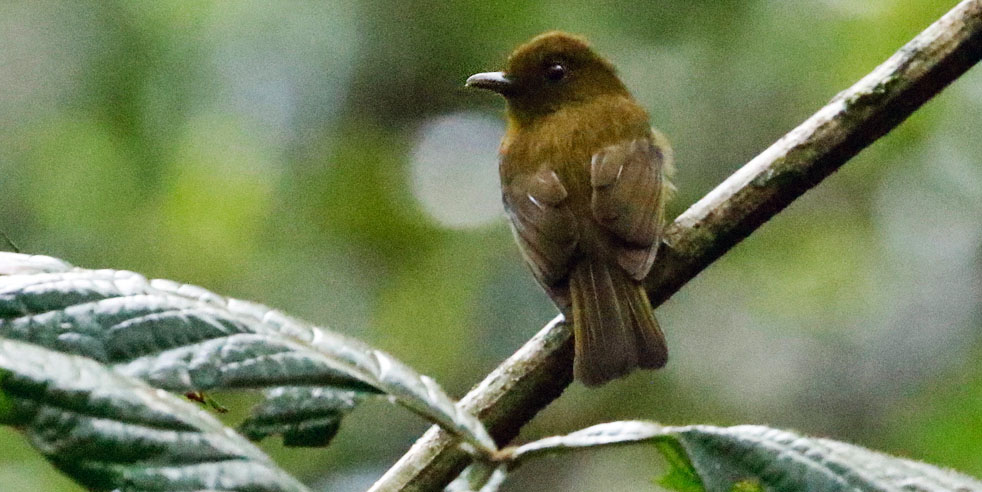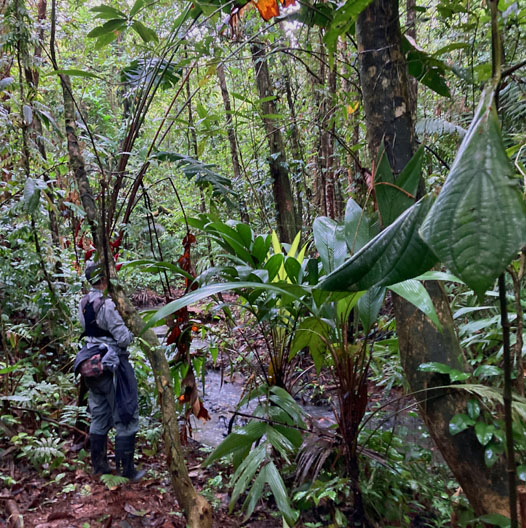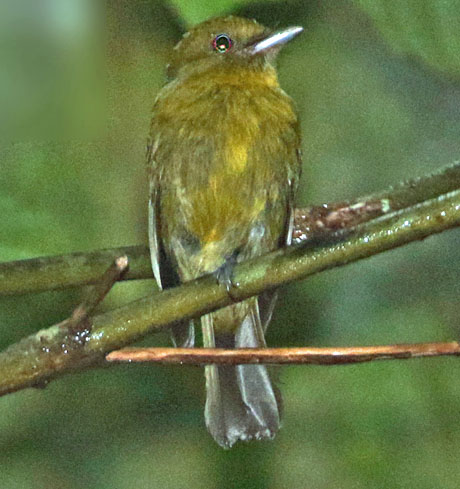
a web page by Don Roberson |
SAPAYOA Sapayoidae |
||
|
||
This bird used to be called "Broad-billed Manakin" and was compared to an overgrown female manakin. One would never guess from its plumage that its closest relatives are the gaudy and colorful broadbills of tropical Asia and Africa. Its true relationships have unfolded with the use of molecular evidence. Lanyon (1985) and Sibley & Ahlquist (1990) were the first to publish evidence that Sapayoa was related to Old World suboscines, and was be the only relict of this ancient lineage remaining in the New World. Prum (1993) studied the phylogeny and biogeography of the asities and broadbills helped sort out their relationships, as did Johansson et al. (2002) among the New World suboscines (more on the taxonomic story below). |
||
 |
||
Sapayoa favors ravines and small streams, and is usually found singly or in pairs. Ridgely & Tudor (1994) remark on its unobtrusive behavior which they liken to flatbills; like them it sits quietly between making short sallies out for food. My most recent encounter with Sapayoa was a pair seen along a slow-moving stream, at the bottom of a muddy ravine in a very humid foothill forest (that habitat is shown at right; photo of the pair are above and below). The forest was multi-layered under a closed canopy, and the pair of Sapayoa were found sitting on vines or branches at or above eye-level most of the time. They sat still, looking around, until an occasional short sally moved them to another perch. Sapayoa feeds on insects captured in the air or on vegetation, and It is known to join mixed species flocks. It also eats fruit. The foraging behaviors are unlike manakins. Rather little is known beyond these few basics. Its nest is a pear-shaped construction of bark with dangling strands and a side entrance (Snow 2020). |
||
|
||
Prum (1993) presented evidence that the asities were embedded among various sets of broadbills, complicating an already complex situation. The full story was not sorted out until Moyle et al. (2006) provided the necessary new research to show the relationship among the (mostly) Old World broadbills. They showed that there were two major clades: (1) a grouping of the Calyptomenna broadbills of Asia (these are the green broadbills) and the Smithornis broadbills of Africa (these are the lowland forest broadbills in Africa), and (2) a grouping of the remaining Asian broadbills (5 genera) plus Grauer's Broadbill Pseudocalyptomena graueri (a montane species which is an Albertine Rift endemic), plus Asities in Madagascar and Sapayoa of the New World. But what to do with this new evidence? The Broadbills as a traditional family are only monophyletic if one considers Asities and Sapayoa to be broadbills. Both the AOU and the SACC initially waffled on their approach to the conundrum, and have variously placed Sapayoa in "Incertae Sedis" [Latin for "don't know what the heck it is"], or as a separate family, or lumped it with all broadbills and asities. The evidence and timing presented by Moyle et al. (2006) suggested that broadbill ancestors arose perhaps 70 million years ago and for some time (perhaps for 10 million years) evolved in what is now India when it was still a huge isolated landmass in the Indian Ocean. When India first crashed into the Eurasian continent in the Paleocene, broadbills spread east (to southeast Asia) and west (to Africa) and in that very warm period, likely north as well. As climate cooled, presumably many species became extinct. Broadbills split into two main branches about 55 million years ago. One of those branches included the Eurylaimid Broadbills, the Sapayoa in the New World, and Asities. Sapayoa became isolated in the New World tropics about 52 million years ago (Moyle et al. 2006). One can debate the accuracy of the dating estimates, but, in short, Sapayoa shares a common ancestor with all broadbills and the asities of Madagascar. One way to look at the evidence is to lump all of them in one huge broadbill assemblage. Another way of handling the exact same evidence is to create four families: the Calyptomenid Broadbills, the Eurylaimid Broadbills, the Asities, and the Sapayoa. To retain Asities or Sapayoa as a family, one must make all those splits. Making the four-way split, and retaining Sapayoa as a family, is consistent with the way the South American Checklist Committee (and this web site) handled a similar problem with the barbet/toucan assemblage. They either had to be one huge family (including toucans), or five separate families. SACC made the latter choice, and I very much approve. I handle the broadbill, asity, and Sapayoa problem in the same way, and retain Sapayoa as a monotypic family of Old World suboscines, isolated in the Neotropics. This approach gained widespread acceptance over time. Now, Sapayoa is widely sought after by world birders, remaining the only "Old World suboscine" in the New World. It is restricted to lowland evergreen forest in the Chocó between central Panama and northwestern Ecuador, and at only a few favored locations. |
||
Photos: Markus Lagerqvist photographed the uppermost Sapayoa Sapayoa aenigma in Panama in Dec 2008. The remaining photos of Sapayoa and its habitat were taken on 10 Feb 2010 near Nusagandi, Guna Yala Province, Panama.
Bibliographic note: There is no "family book" for this enigma. The Handbook of Birds of the World series reached the suboscines in 2004, and treated Sapayoa among the manakins [Pipridae] but acknowledged that its relationships were subject to further research. Literature cited:
|
 In tropical lowland forests from Panama to northwest Ecuador lives an enigma. Its formal name is Sapayoa aenigma; even this means "enigma" in Latin. It is an inconspicuous, dull-colored bird of the forest understory where it is rare to uncommon. The bird is now known as Sapayoa (left; a very nice shot by Markus Lagerqvist. All other photos on this page by D. Roberson). It is now assigned to is own monotypic family.
In tropical lowland forests from Panama to northwest Ecuador lives an enigma. Its formal name is Sapayoa aenigma; even this means "enigma" in Latin. It is an inconspicuous, dull-colored bird of the forest understory where it is rare to uncommon. The bird is now known as Sapayoa (left; a very nice shot by Markus Lagerqvist. All other photos on this page by D. Roberson). It is now assigned to is own monotypic family. 

